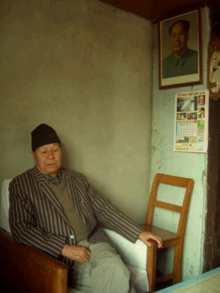- Narayan Man Bijukchhe
-
Narayan Man Bijukchhe (Nepali: नारायणमान बिजुक्छे, party name 'Rohit',[1] born March 9, 1940[2][3][4]) is a Nepalese politician. Bijukchhe is the president of the Nepal Workers and Peasants Party.[5]
Bijukchhe was born in Sukuldhoka, Nepal. He became a communist sympathizer after seeing the relief work of Communist Party of Nepal cadres during floods in Rautahat around 1954. Around 1956 he joined the Students Federation and became a Communist Party member the following year. Bijukchhe became a prominent figure in the agrarian struggles in the Dhanusa, Parsa and Rautahat districts. In 1961 he became the president of the Students Union at Bhaktapur College.[2][4]
In the early 1970s, Bijukchhe became a Central Committee member of Pushpa Lal Shrestha's Communist Party of Nepal. He was put in charge of the Bagmati, Narayani and Janakpur zone.[2] He went against the leadership of Pushpa Lal Shrestha. Bijukchhe criticized the decision of Pushpa Lal and the party to support the Indian intervention in East Pakistan, the policy of seeking cooperation with Nepali Congress and the failure of the party to condemn the Soviet Union as imperialist.[1]
In 1975 he founded the Nepal Workers and Peasants Organisation (which later became the Nepal Workers and Peasants Party).[2][6] The influence of the group remained largely confined to Bhaktapur, but in that area it became successful in mobilizing tenants and gaining influence inside panchayat institutions.[7]
During the 1990s, Bijukchhe was elected to parliament three times, in 1991, 1994 and 1999.[2] In 2006, Bijukchhe was one of the signatories of the historic agreement between the Seven Party Alliance and the Communist Party of Nepal.[5] In the 2008 Constituent Assembly election, Bijukchhe won the Bhaktapur-1 seat with 19,972 votes,[8] Bijukchhe has emerged as a strong critic of the proposal to divide Nepal into ethnic and linguistic states, arguing that such a federalist concept might produce violent conflicts.[4][9] thus having won a seat in all national elections since the 1990 Jana Andolan.[10]
On June 12, 2010 Bijukchhe withdrew his support to the coalition government led by Madhav Kumar Nepal.[11]
References
- ^ a b Parajulee, Ramjee P. The Democratic Transition in Nepal. Rowman & Littlefield, 2000. p. 57
- ^ a b c d e Name: Narayan Man Bijukchhe alias 'Rohit'
- ^ Whelpton, John. A History of Nepal. Cambridge: Cambridge University Press, 2005. p. 239
- ^ a b c Maoists are fooling people: Bijukchhe
- ^ a b Upreti, B. C. Maoists in Nepal: From Insurgency to Political Mainstream. New Delhi: Kalpaz Publications, 2008. p. 238
- ^ Rawal, Bhim Bahadur. Nepalma samyabadi andolan: udbhab ra vikas. Kathmandu: Pairavi Prakashan. Chart no. 1.
- ^ Whelpton, John. A History of Nepal. Cambridge: Cambridge University Press, 2005. p. 106
- ^ Upreti, B. C. Nepal: Transition to Democratic Republican State : 2008 Constituent Assembly. Delhi: Kalpaz Publications, 2010. p. 189
- ^ Bijukchhe opposes ethnic division
- ^ Carter Center. Observing the 2008 Nepal Constituent Assembly Election
- ^ Bijukchhe withdraws support to govt
Categories:- Communist Party of Nepal (Pushpa Lal) politicians
- Nepal Workers Peasants Party politicians
- 1940 births
- Living people
Wikimedia Foundation. 2010.

